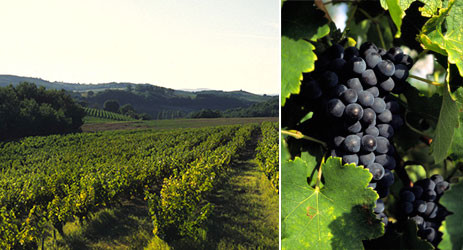This old, dark-skinned variety, a grandparent of Carmenère, goes by many names (Braucol, Fer Servadou, Hère, Mansois, Pinenc) and is most commonly associated with southwest France and appellations such as Marcillac, Gaillac, Madiran and St-Mont, often as part of a blend (eg, with Syrah or Gamay).
 Image: Gaillac vineyards (left) and Fer grape (right) by BerndtF,
Image: Gaillac vineyards (left) and Fer grape (right) by BerndtF,
and adapted under the Creative Commons BY-SA 3.0 Unported license.
Though its origins are most likely in Spanish Basque country, in Marcillac it shines as a deep coloured varietal wine with a superb wild side.
You might find similarities with Cabernet Franc and it can be on the rustic side, with lively fruit flavours both red and black. Tannins are often firm but there’s usually a fine freshness that makes it a delicious supper wine. Research suggests that Fer is rich in catechins and procyanidols, thought to inhibit cardiovascular disease.
The name probably derives from the Latin ferus meaning ‘wild’ (because it was domesticated from wild vines) rather than from the French word meaning ‘iron’ (referring to the hardness of the vine’s wood).
Try examples from Domaines Laurens, Genouillac, du Cros, des Costes Rouges, du Mioula, the Cave Coopérative des Vignerons du Vallon and Le Vieux Porche.
Wine Grapes by Jancis Robinson MW, Julia Harding MW and José Vouillamoz; www.winegrapes.org
All rights reserved by Future plc. No part of this publication may be reproduced, distributed or transmitted in any form or by any means without the prior written permission of Decanter.
Only Official Media Partners (see About us) of DecanterChina.com may republish part of the content from the site without prior permission under strict Terms & Conditions. Contact china@decanter.com to learn about how to become an Official Media Partner of DecanterChina.com.

Comments
Submit